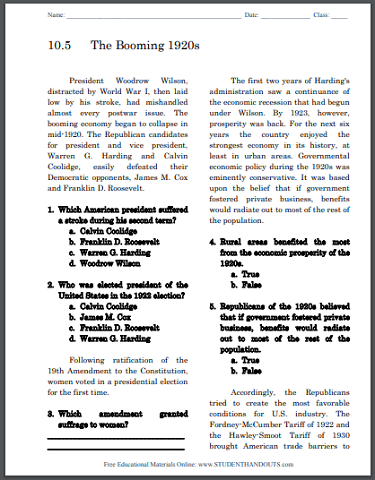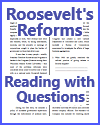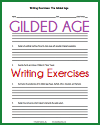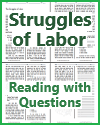The Booming 1920s |
President Woodrow Wilson, distracted by
World War I, then laid low by his stroke, had mishandled almost
every postwar issue. The booming economy began to collapse in
mid-1920. The Republican candidates for president and vice
president, Warren G. Harding and Calvin Coolidge, easily
defeated their Democratic opponents, James M. Cox and Franklin
D. Roosevelt. 1. Which American president suffered a stroke during his second term? a. Calvin Coolidge b. Franklin D. Roosevelt c. Warren G. Harding d. Woodrow Wilson 2. Who was elected president of the United States in the 1922 election? a. Calvin Coolidge b. James M. Cox c. Franklin D. Roosevelt d. Warren G. Harding  Following ratification of the 19th Amendment to the
Constitution, women voted in a presidential election for the
first time. Following ratification of the 19th Amendment to the
Constitution, women voted in a presidential election for the
first time.3. Which amendment granted suffrage to women? The first two years of Harding's administration saw a continuance of the economic recession that had begun under Wilson. By 1923, however, prosperity was back. For the next six years the country enjoyed the strongest economy in its history, at least in urban areas. Governmental economic policy during the 1920s was eminently conservative. It was based upon the belief that if government fostered private business, benefits would radiate out to most of the rest of the population. 4. Rural areas benefited the most from the economic prosperity of the 1920s. a. True b. False 5. Republicans of the 1920s believed that if government fostered private business, benefits would radiate out to most of the rest of the population. a. True b. False Accordingly, the Republicans tried to create the most favorable conditions for U.S. industry. The Fordney-McCumber Tariff of 1922 and the Hawley-Smoot Tariff of 1930 brought American trade barriers to new heights, guaranteeing U.S. manufacturers in one field after another a monopoly of the domestic market, but blocking a healthy trade with Europe that would have reinvigorated the international economy. Occurring at the beginning of the Great Depression, Hawley-Smoot triggered retaliation from other manufacturing nations and contributed greatly to a collapsing cycle of world trade that intensified world economic misery. 6. What two American tariffs stood as barriers to trade with Europe? The federal government also started a program of tax cuts, reflecting Treasury Secretary Andrew Mellon's belief that high taxes on individual incomes and corporations discouraged investment in new industrial enterprises. Congress, in laws passed between 1921 and 1929, responded favorably to his proposals. 7. Why did the United States cut taxes for individuals and corporations during the 1920s? "The chief business of the American people is business," declared Calvin Coolidge, the Vermont-born vice president who succeeded to the presidency in 1923 after Harding's death, and was elected in his own right in 1924. Coolidge hewed to the conservative economic policies of the Republican Party, but he was a much abler administrator than the hapless Harding, whose administration was mired in charges of corruption in the months before his death. 8. Who became president of the United States in 1923, following the death of Warren G. Harding? Throughout the 1920s, private business received substantial encouragement, including construction loans, profitable mail-carrying contracts, and other indirect subsidies. The Transportation Act of 1920 (also known as the Esch-Cummins Act), for example, had already restored to private management the nation's railways, which had been under government control during the war. The Merchant Marine, which had been owned and largely operated by the government, was sold to private operators. 9. What two important trade and transportation organizations were privatized during the 1920s? Republican policies in agriculture, however, faced mounting criticism, for farmers shared least in the prosperity of the 1920s. The period since 1900 had been one of rising farm prices. The unprecedented wartime demand for U.S. farm products had provided a strong stimulus to expansion. But by the close of 1920, with the abrupt end of wartime demand, the commercial agriculture of staple crops such as wheat and corn fell into sharp decline. Many factors accounted for the depression in American agriculture, but foremost was the loss of foreign markets. This was partly in reaction to American tariff policy, but also because excess farm production was a worldwide phenomenon. When the Great Depression struck in the 1930s, it devastated an already fragile farm economy. 10. What was the leading cause for the depression in American agriculture following World War I? The distress of agriculture aside, the Twenties brought the best life ever to most Americans. It was the decade in which the ordinary family purchased its first automobile, obtained refrigerators and vacuum cleaners, listened to the radio for entertainment, and went regularly to motion pictures. Prosperity was real and broadly distributed. The Republicans profited politically, as a result, by claiming credit for it. 11. List three examples of mass consumption common in the 1920s. 12. Imagine that you are part of a farming family during the 1920s, watching those living in cities thrive as you grow poorer and poorer. How might you feel about the presidencies of Harding and Coolidge? Explain your answer. |
Answer Key |
1. D - Woodrow Wilson 2. D - Warren G. Harding 3. 19th Amendment 4. B - False 5. A - True 6. Fordney-McCumber Tariff of 1922 and Hawley-Smoot Tariff of 1930 7. Belief that high taxes on individual incomes and corporations discouraged investment in new industrial enterprises 8. Calvin Coolidge 9. Railroads and Merchant Marine 10. Loss of foreign markets 11. Answers will vary, but may include automobiles, refrigerators, vacuum cleaners, radio, and motion pictures 12. Answers will vary |
Click
here
to print this worksheet. |
 |
|---|
Text courtesy of the U.S. State Department,
Bureau of International Information Programs, 2005 |










